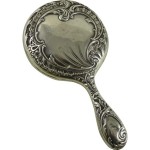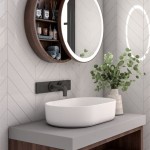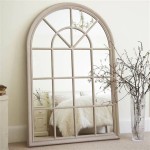```html
How To Make A Mirror Frame Look Antique
Transforming a standard mirror frame into an antique-looking piece can add a touch of vintage elegance to any room. This process involves specific techniques that mimic the effects of aging and wear, resulting in a frame that appears to have a long history. The techniques described below range from simple distressing to more complex layering and finishing, allowing for a customized antique aesthetic.
Preparing the Frame
The initial stage of any antique finishing project involves preparing the surface. This preparation ensures proper adhesion of materials and contributes to the overall realism of the aged look. The frame must be clean, dry, and free from any existing finishes that may interfere with the new layers being applied. The type of preparation required depends largely on the existing state of the frame.
For new, unfinished wood frames, a light sanding with fine-grit sandpaper (around 220 grit) is usually sufficient. This sanding roughens the surface slightly, providing a better grip for paint and other finishes. Remove all sanding dust with a tack cloth or a damp cloth before proceeding to the next step.
Frames that already have a painted or varnished finish require a more thorough preparation. If the existing finish is in good condition (no peeling or chipping), it can be lightly sanded to create a key for the new layers. If the existing finish is peeling or chipping, it should be completely removed. This can be achieved through sanding, chemical stripping, or a combination of both. When using chemical strippers, always follow the manufacturer's instructions carefully and wear appropriate safety gear, including gloves and eye protection.
Once the existing finish has been removed or prepared, inspect the frame for any dents, scratches, or imperfections. These imperfections can be filled with wood filler and sanded smooth once dry. The goal is to create a smooth, even surface that will serve as the foundation for the antique finish.
Finally, after all repairs and surface preparation are complete, apply a primer. A primer helps to seal the wood, even out the surface, and improve the adhesion of subsequent layers of paint and finish. Choose a primer that is compatible with the type of paint you plan to use. Apply the primer in thin, even coats, allowing it to dry completely before moving on to the next step. Lightly sand the primer coat with fine-grit sandpaper to ensure a smooth surface for painting.
Applying Distressed Paint
Distressing paint is a core technique for creating an antique look. This involves applying paint in a way that simulates the wear and tear that naturally occurs over time. Several methods can be used to achieve this effect, each producing a slightly different result.
One common method is dry brushing. This technique involves using a brush with very little paint on it. Dip the brush into the paint, then wipe off most of the paint onto a paper towel until the brush appears almost dry. Then, lightly brush the frame, allowing the underlying layers to show through. This creates a subtle, textured effect that mimics the look of worn paint.
Another technique is layering different colors of paint. Start with a base coat in a dark color, such as black, brown, or dark grey. Allow the base coat to dry completely. Then, apply a second coat in a lighter color, such as cream, off-white, or light grey. While the second coat is still wet, use a damp cloth or sponge to gently rub away some of the paint, revealing the dark base coat underneath. This creates a layered effect that adds depth and character to the frame. Consider using a resist, such as petroleum jelly or wax, in areas where you want the base coat to be more prominent. Apply the resist before the top coat, and then wipe it away after applying the top coat to reveal the underlying layer.
Sanding is another essential technique for distressing paint. After the paint has dried completely, use sandpaper to lightly sand the edges, corners, and other areas that would naturally experience wear and tear. This will reveal the underlying layers of paint or the bare wood beneath, creating a worn and aged look. Vary the pressure and direction of sanding to create a more natural and random effect. Use different grits of sandpaper, starting with a coarser grit and gradually moving to a finer grit, to create a smooth transition between the layers.
Chipping is another method to add character. Carefully chip away small pieces of paint using a putty knife or a similar tool. Focus on areas that would naturally experience damage, such as edges and corners. The goal is to create a realistic effect of age and wear, not a perfectly uniform pattern of damage.
Adding Patina and Finishing Touches
Once the paint has been applied and distressed, adding patina and finishing touches can enhance the antique appearance of the frame. Patina refers to the subtle discoloration and staining that occurs over time, adding depth and character to aged objects.
One way to create a patina effect is to use antiquing glaze. Antiquing glaze is a translucent stain that can be applied over the painted surface to add a warm, aged tone. Apply the glaze with a brush or cloth, then wipe away the excess with a clean cloth. The glaze will settle into the crevices and textured areas of the frame, highlighting the details and creating a sense of depth. Experiment with different colors of antiquing glaze to achieve the desired effect. Brown, umber, and sepia tones are commonly used to create an aged appearance.
Another technique is to use wax. Apply a thin layer of wax over the painted and distressed surface. The wax will protect the paint and add a subtle sheen. Dark wax can be used to further enhance the aged look by darkening the crevices and adding a sense of depth. Apply the dark wax with a brush or cloth, then wipe away the excess with a clean cloth. Buff the wax with a soft cloth to create a smooth, polished finish.
For a more authentic aged look, consider adding faux dirt or grime. This can be achieved by lightly dusting the frame with a dry pigment powder, such as burnt umber or raw sienna. Use a soft brush to apply the pigment to the recesses and crevices of the frame, then lightly wipe away the excess with a clean cloth. This will create a subtle, aged appearance that mimics the accumulation of dirt and grime over time.
Finally, protect the finished frame with a clear coat of varnish or lacquer. This will seal the paint and patina, protecting them from damage and ensuring that the antique finish lasts for years to come. Choose a clear coat with a matte or satin finish to maintain the aged appearance. Apply the clear coat in thin, even coats, allowing it to dry completely between coats. Lightly sand the clear coat with fine-grit sandpaper before applying the final coat to ensure a smooth, even finish.
By following these techniques, it is possible to transform an ordinary mirror frame into an antique-looking piece that adds character and elegance to any space. Remember to experiment with different techniques and materials to achieve the desired look and to have patience throughout the process.
```
How To Antique A Mirror Tutorial Jenna Sue Design

How To Antique A Mirror Tutorial Jenna Sue Design

12 Techniques To Painting Antique Mirrors Hallstrom Home

The Ultimate Guide On Diy Antique Mirrors So Much Better With Age

Antique Diy Mirror Frame Arinsolangeathome

Diy Antique Mirror Easy To Do And Looks Authentic My Creative Days

The Ultimate Guide On Diy Antique Mirrors So Much Better With Age

How To Antique A Mirror Tutorial Jenna Sue Design

Diy Mercury Glass Gilded Mirror Made From Old Photo Frames

Chalk Paint And Antiquing A Frame Diy Dekor Ramar







